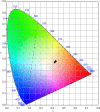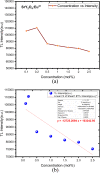Optimizing the luminescence efficiency of an europium (Eu3+) doped SrY2O4 phosphor for flexible display and lighting applications
- PMID: 37416907
- PMCID: PMC10320686
- DOI: 10.1039/d3ra03199c
Optimizing the luminescence efficiency of an europium (Eu3+) doped SrY2O4 phosphor for flexible display and lighting applications
Abstract
This research paper reports the synthesis and luminescence study of an Eu3+ activated SrY2O4 phosphor prepared by a modified solid-state reaction method with varying concentrations of Eu3+ ions (0.1-2.5 mol%). X-ray diffraction (XRD) revealed the orthorhombic structure and Fourier transform infrared spectroscopy (FTIR) methods were used to analyse the produced phosphors. Photoluminescence emission and excitation spectra were recorded for varying concentrations of Eu3+ ions, and an optimum concentration of 2.0 mol% was found to produce the highest intensity. Under 254 nm excitation the emission peaks were found to be at 580 nm, 590 nm, 611 nm and 619 nm, corresponding to transitions at 5D0 → 7F0, 5D0 → 7F1, and 5D0 → 7F2 respectively. Because of Eu3+ inherent luminosity, these emission peaks indicate radiative transitions between excited states of ions, making them useful for developing white light-emitting phosphors for optoelectronic and flexible display applications. The 1931 CIE (x, y) chromaticity coordinates were calculated from the photoluminescence emission spectra and found to be near white light emission, indicating the potential application of the prepared phosphor for light emitting diodes (white component). TL glow curve analysis was also performed for various concentrations of doping ions and UV exposure times, and a single broad peak was observed at 187 °C. Using the computerised glow curve deconvolution (CGCD) method, kinetic parameters were computed.
This journal is © The Royal Society of Chemistry.
Conflict of interest statement
There are no conflicts to declare.
Figures












Similar articles
-
Investigation of Spectroscopic Parameters and Trap Parameters of Eu3+-Activated Y2SiO5 Phosphors for Display and Dosimetry Applications.Molecules. 2024 Dec 30;30(1):108. doi: 10.3390/molecules30010108. Molecules. 2024. PMID: 39795164 Free PMC article.
-
Intense green light emission and thermoluminescence glow curve analysis of Tb3+ -activated CaY2 O4 phosphor.Luminescence. 2023 Sep;38(9):1591-1596. doi: 10.1002/bio.4541. Epub 2023 Jul 11. Luminescence. 2023. PMID: 37329119
-
Synthesis and luminescence characterization of Eu3+ -doped Ca7 Mg2 (PO4 )6 phosphor for eco-friendly white light-emitting diodes and thermoluminescence dosimetric applications.Luminescence. 2021 Dec;36(8):1837-1846. doi: 10.1002/bio.3900. Epub 2021 Apr 27. Luminescence. 2021. PMID: 32609916
-
Synthesis, structure and luminescence properties of bifunctional KCaF3 phosphor influenced by incorporating Eu3+ ions for solid state lighting and TL dosimetry applications.Appl Radiat Isot. 2023 Jan;191:110520. doi: 10.1016/j.apradiso.2022.110520. Epub 2022 Oct 19. Appl Radiat Isot. 2023. PMID: 36327612
-
Synthesis and characterization of a Eu3+ -activated Ba2-x V2 O7 :xEu3+ phosphor using a hydrothermal method: a potential material for near-UV-WLED applications.Luminescence. 2021 Jun;36(4):849-859. doi: 10.1002/bio.4031. Epub 2021 Mar 1. Luminescence. 2021. PMID: 33569861 Review.
Cited by
-
High Quantum Yields and Biomedical Fluorescent Imaging Applications of Photosensitized Trivalent Lanthanide Ion-Based Nanoparticles.Int J Mol Sci. 2024 Oct 24;25(21):11419. doi: 10.3390/ijms252111419. Int J Mol Sci. 2024. PMID: 39518971 Free PMC article. Review.
-
Influence of Eu3+ Doping on Physiochemical Properties and Neuroprotective Potential of Polyacrylic Acid Functionalized Cerium Oxide Nanoparticles.Int J Mol Sci. 2024 Feb 21;25(5):2501. doi: 10.3390/ijms25052501. Int J Mol Sci. 2024. PMID: 38473749 Free PMC article.
References
-
- Celikel D. C., Smart E-Textile Materials, in Advanced functional materials, ed. N. Tasaltin, P. S. Nnamchi and S. Saud, IntechOpen, London, 2020, pp. 1–16, 10.5772/intechopen.92439 - DOI
-
- Liu L. Xu W. Ding Y. Agarwal S. Greiner A. Duan G. A review of smart electrospunfibers toward textiles. Comput. Commun. 2020;22:100506. doi: 10.1016/j.coco.2020.100506. - DOI
-
- Ghahremani Honarvar M. Latifi M. Overview of wearable electronics and smart textiles. J. Text. Inst. 2017;108(4):631–652. doi: 10.1080/00405000.2016.1177870. - DOI
-
- Chen M. Ma Y. Song J. Lai C. F. Hu B. Smart clothing: connecting human with clouds and big data for sustainable health monitoring. Mob. Netw. Appl. 2016;21(5):825–845. doi: 10.1007/s11036-016-0745-1. - DOI
-
- Bratovcic A. Different applications of nanomaterials and their impact on the environment. Int. J. Mater. Sci. Eng. 2019;5(1):1–7. doi: 10.14445/23948884/IJMSE-V5I1P101. - DOI
LinkOut - more resources
Full Text Sources

